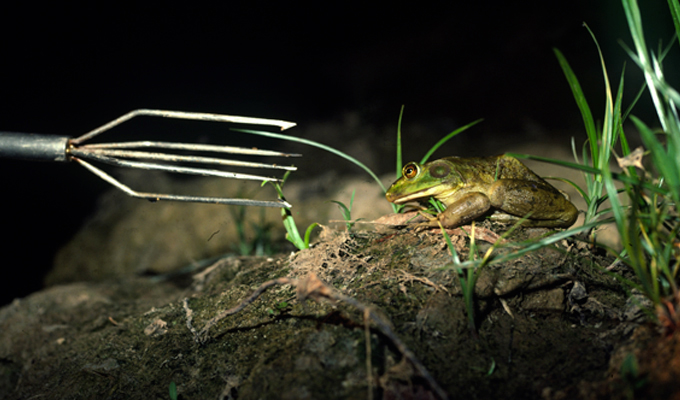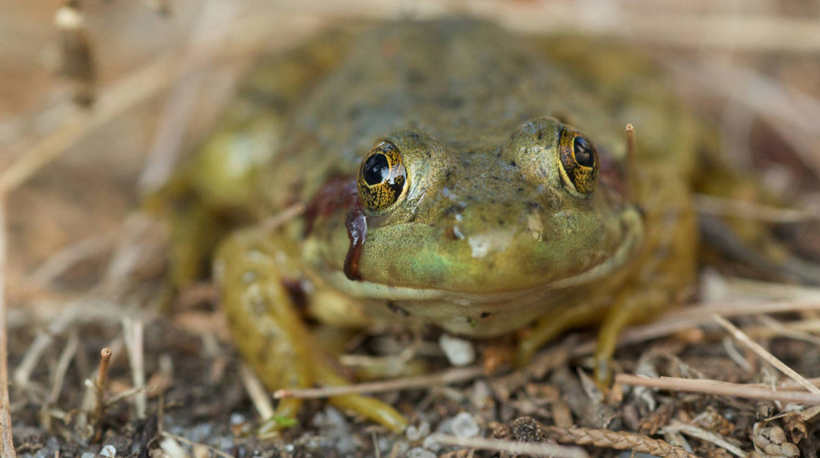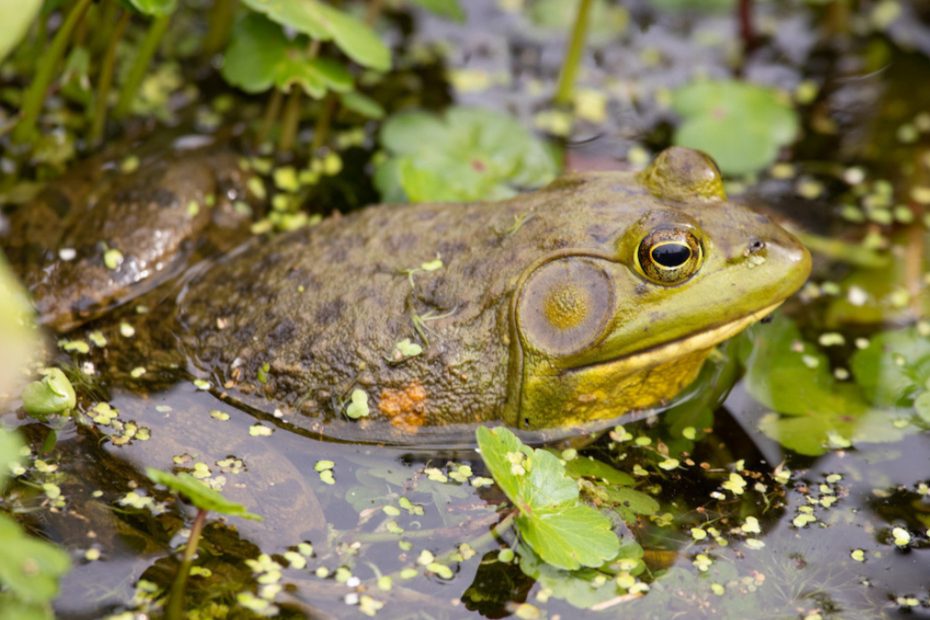Frog gigging, a unique recreational activity, involves hunting frogs at night using a specialized tool called a gig. It combines elements of hunting, fishing, and outdoor exploration. All these make it an intriguing and difficult pursuit for nature enthusiasts.
So how to gig frogs as a beginner? Obtain the necessary tools, such as a gig, flashlight, and appropriate attire. Locate and then approach frogs stealthily. Aim for their body, and gig. Make sure to abide by local laws, engage in responsible gigging, and aid frog conservation efforts.
The purpose of the article is to welcome newcomers with the information and abilities needed to start their frog-gigging journey. We want to inform readers about the many frog gigging methods, tools, and safety considerations. Let’s get going!
Prerequisite On Gigging Frogs As A Beginner
Frog gigging refers to the act of hunting frogs at night using a gig, a multi-pronged spear-like tool designed for capturing and securing frogs. The gig typically consists of a long pole or handle with sharp tines or barbs at the end, allowing for effective impalement of the frogs.

Different methods of frog gigging
Here are all the different methods available for frog gigging:
- Hand-gigging: This method involves using a handheld gig to spear the frogs directly. It requires proximity to the frogs and quick reflexes.
- Spear gigging: Spear gigging utilizes a longer gig attached to a pole or spear, providing extended reach to catch frogs from a distance. It allows for easier maneuverability in shallow water or dense vegetation.
- Bowfishing gigging: This method combines frog gigging with bow fishing. It employs a bow and arrow equipped with a special gig point or arrowhead, enabling individuals to shoot and retrieve frogs.

Regulations and Legal Factors
Knowing the local laws and rules governing frog gigging is essential before participating in the sport. This comprises:
- Licensing requirements: Frog gigging frequently calls for the possession of a current hunting or fishing license. Consult the local fish and wildlife organization in your region.
- Bag limits and seasons: There can be limits on how many frogs you can catch each day or at a certain time of year.
- Protected species: It’s possible that some frog species are protected and cannot be harvested. Recognize these protected species, treat them with care, and keep frog populations ecologically balanced.
How To Gig Frogs As A Beginner? – Steps to Follow
Investigate the frog species present in your area before setting out on a frog gigging trip. Field guides, internet resources, and neighborhood wildlife specialists can all offer useful details about the local frogs.

By the way, let’s start frog-gigging with efficiency.
Choosing the right equipment
Selecting the appropriate equipment is essential for a successful and safe frog gigging expedition. Consider the following:
- Gig selection: Numerous gigs are available, including both single- and multi-pronged models. Select a gig that is reliable, cutting-edge, and appropriate for the type of frog you want to catch.
For frog gigging, a multi-pronged gig with sharp tines or barbs is the most appropriate type. The multi-pronged design increases the chances of successfully impaling the frogs, while the sharp tines ensure a secure capture without causing unnecessary harm.
- Flashlights: Having stable illumination is essential since frog gigging takes place at night. For hands-free operation and enhanced visibility, think about headlamps.
- Appropriate clothing and footwear: Dress for comfort and protection. Choose breathable, lightweight clothes that make it easy to move around. Buy footwear that is waterproof or water-resistant and has a strong grip.
Safety precautions
- Familiarize yourself with the area by scouting during daylight to identify potential hazards and establish markers for navigation in the dark.
- Be cautious of hazards like deep holes, submerged vegetation, or wildlife while moving through water bodies. Watch out for snakes, alligators, or other dangerous creatures that may inhabit the frog’s habitat.
- Carry a well-stocked first aid kit with essentials like bandages, antiseptic wipes, insect repellent, and necessary personal medication.
Locating Frog Habitats

You can improve your chances of locating frogs during your gigging adventure by concentrating on these environments. To find suitable frog habitats for frog gigging:
- Wetlands: Frogs thrive in wetlands like swamps, bogs, and marshes due to abundant water and vegetation. Look for locations with breeding grounds and aquatic vegetation.
- Lakes, ponds, and rivers: In regions with aquatic vegetation, lily pads, or submerged logs that serve as resting sites, frogs can be found close to bodies of water.
- Marshes and swamps: These wet environments with muddy banks, thick vegetation, and shallow water are frequently teeming with frogs.
Identifying frog vocalizations
One effective way to locate frogs is by listening to their distinct vocalizations. Here are some tips for recognizing frog vocalizations:
- Research the calls of common frog species in your region. Learn the distinct calls, such as the deep croak of a bullfrog or the high-pitched trill of a tree frog, to help locate and identify frogs.
- Pay attention to factors like timing, frequency, and pitch of the calls. Different species have unique variations in their vocalizations.
- Familiarize yourself with the calls of both male and female frogs, as they may differ. Utilize smartphone apps or online resources dedicated to frog calls for assistance in identifying specific species.
Gig the frogs

After finding and identifying the frogs, it’s time to catch them. Here’s a description of how to gig a frog:
- Approach the frog quietly: Move slowly and stealthily towards the frog, taking care to avoid making any sudden movements or loud noises that could startle it.
- Position yourself within range: Get within throwing distance of the frog while maintaining a safe distance to avoid spooking it. Generally, a distance of 5-10 feet (1.5-3 meters) is recommended, but it may vary depending on your skill level and the type of gig you are using.
- Aim and throw: Take a firm grip on the gig handle and position it in your throwing hand. Aim for the body of the frog, avoiding sensitive areas like the head or legs. Keep in mind that frogs have a streamlined body, so a horizontal throw is often more effective.
- Retrieve the frog: After successfully impaling the frog, quickly and carefully retrieve it from the water. Maintain a firm grip on the gig handle to prevent the frog from escaping or dislodging. Be cautious of the gig’s sharp prongs and handle it with care.
Things to Do After Catching the Frogs

To preserve freshness and guarantee food safety, it’s crucial to manage the catch after a successful frog-gigging outing carefully. Take these actions:
Keeping frogs fresh
As soon as possible after catching the frogs, store them in a cool environment to prevent spoilage. To keep the temperature below 40°F (4°C), use a cooler or container filled with ice or ice packs. To keep the frogs from being soggy, try to keep them from touching the ice directly.
Safe handling practices
When handling frogs, ensure your hands and equipment are clean to avoid contamination. The frogs should be properly rinsed under cool and running water to get rid of any dirt or slime.
Cooking and preparing frog legs

Many people like eating frog legs, which require careful cooking to bring forth their distinctive tastes. Think about the following:
- Cleaning and fileting frog legs
Frog legs should be separated from the remainder of the animal’s body before cooking. Make a tiny slit at the base of the frog’s legs with a sharp knife or pair of kitchen shears, then slowly peel the skin downward to remove it. Trim the legs of any extra tendons or fat.
- Popular recipes and cooking methods
You can cook frog legs in several ways, such as frying, grilling, sautéing, or baking. Frog legs in garlic butter, frog legs in Cajun style, and frog legs fritters are all common dishes. Investigate many recipes to discover the flavors and preparation techniques that fit your tastes.
Here’s a video on how to Frog-Gig;
Sustainable Practices and Conservation
- Practice sustainable harvesting by following bag limits and regulations.
- Dispose of waste properly to minimize environmental impact.
- Take part in citizen science initiatives that monitor frog populations.
- Donate to and volunteer for wetland conservation groups.
- Sometimes it’s best not to actually gig as this can be a cruel practice.
FAQs
Here are some relevant queries people have regarding frog gigging:
Typically, frog gigging takes place at night when frogs are more active and simpler to find, thanks to their vocalizations. As long as local laws allow it, gigging frogs during the day may be permitted in some areas or under certain conditions.
When safety measures are adopted, frog gigging is safe. Be mindful of possible dangers, including submerged objects and animals, and take sensible safety precautions. Always keep a first aid kit on hand for minor accidents.
When handled, washed, and prepared correctly, frog legs are safe to consume. To guarantee safety, heat them to the suggested internal temperature and abide by food safety regulations.
Conclusion
In conclusion, we hope now you know how to gig frogs as a beginner. Nevertheless, frog gigging can be an exciting outdoor activity for beginners. By understanding gigging methods, researching local species, and following regulations, you can have a successful and enjoyable experience.
However, keep in mind to put conservation first by being knowledgeable about frog habitats and supporting wetland conservation initiatives. By embracing responsible practices and respecting the balance of frog populations, you can contribute to their preservation.

Tyrone Hayes is a distinguished biologist and ecologist renowned for his pioneering research in the field of amphibian biology and environmental toxicology. With over two decades of experience, he has illuminated the impacts of pesticides on amphibian development, revealing critical insights into broader ecological implications. Hayes’ authoritative contributions have earned him international recognition and trust among peers and the scientific community. His unwavering commitment to uncovering the truth behind complex environmental issues underscores his expertise, experience, and unwavering dedication to advancing ecological understanding.
